Table of contents
- Technology explained Everything about frame types
- Framed
- Double loop frame
- Monotube frame
- Bridge frame with beams
- Aluminum bridge frame
- Truss bridge frame
- Tubular steel bridge frame
- Load during emergency braking
- Load with payload
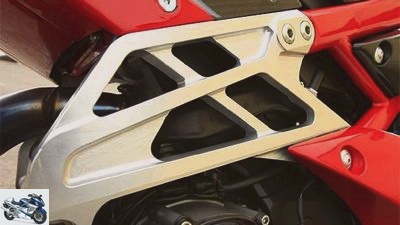
archive
counselor
technology & future
Technology frame types
Technology explained
Everything about frame types
Full braking, marginal lean or full shower at almost 300 km / h: Modern motorcycle frames keep the wheels safely on track. And that with very different concepts.
Werner Koch
09/24/2009
Framed
The designation “frame” hits the nail on the head with conventional motorcycle chassis. After all, the classic double loop frames stretched around the entire engine, which remained almost free of all bending forces that build up on a motorcycle. The engine housing and cylinder block could be constructed accordingly light and filigree. In addition, this framework concept allowed an elastic mounting of the engine in order to master the vibrations.
The original and logical idea of connecting the steering head to the swing arm mounting in the shortest possible way, however, fell by the wayside with the conventional double loop frame.
Some famous machines such as the NSU Max (sheet metal profile bridge frame) or the rare Horex RS 350 from 1954 (bridge frame made of triangular connections) showed that the integration of the motor as a load-bearing element guarantees high stability with extremely little weight if the motor housing was shaped according to the loads.
In the mid-1980s, motorcycles again rolled off the assembly line that used the frame / engine combination. Honda’s VFR 750 F from 1986 had the first frame corset made of aluminum profiles, the competition followed suit, and Yamaha went one step further with the FZR 1000 Genesis with an aluminum delta box frame. On closer analysis of the beautiful Deltabox construction, however, it became clear that the function was only guaranteed because the bolted beams, which held the motor in elastic rubber mountings, stabilized the structure.
Only when the engine housing was screwed rigidly into the aluminum frame (Honda VFR 750 F / R, Yamaha FZR 750R etc.) was the torsional stiffness of the composite construction optimally used.
In order to save costs, the elaborately welded constructions made of shiny shaped sheet metal (Yamaha YZF R1 from 1998) or elegant extruded profiles were replaced by inexpensive cast parts. Although some of these bridge frames span the motor in a filigree form, the screwed motor housing creates a large enclosed space that has the bending forces and moments under control.
Ducati pursues the same principle, but with a completely different technical and visual approach. Instead of cast aluminum, the Italians use triangular steel pipes that integrate the engine easily and extremely stably. Ducati also uses the independent frame layout as a distinctive design element. Painted red and visibly displayed, the Ducati frame stands out from the Japanese mass-produced goods.
Also made of steel, but much simpler in shape and design, so-called single-tube frames for enduro bikes or inexpensive mid-range machines ensure sufficiently high stability at minimal costs.
Regardless of whether it is a tubular steel or aluminum frame, there are great mechanical demands on all constructions. A certain flexural and torsional rigidity must be guaranteed in order to keep the wheels on track even under high loads without twisting. However, if the rigidity is set too high, the driving comfort and the feedback to the driver suffer. This means that the frame should support the suspension with a certain flexibility in the steering head area in the vertical direction, i.e. with short hard impacts, without twisting during hard braking maneuvers. Tasks that can be roughly sketched out using computer calculations, but can only actually be proven in real driving tests.
The designers achieve this mix of the necessary rigidity and targeted flexibility by using walls and profile cross-sections of different thicknesses. The teams in MotoGP demonstrate how complex and sometimes contradicting this chassis hocus-pocus can be. There, frames are reinforced from one race to the other, then weakened again in order to have even more rigidity two races later with even more material or components made of carbon.
The brutal forces applied to a motorcycle frame can be clearly demonstrated by applying the brakes with a pillion passenger or fully compressing a touring bike weighing around 400 kilograms. These forces and moments in the barrel range are created by the lever action of the fork or the mechanical translation of the spring forces on the rocker arm. In the frame area between the swing arm bearing and the upper suspension strut eye, forces of up to a thousand kilograms occur when driving over bumps. And this is exactly where the most delicate task in frame construction lies. The frame has to withstand thousands of force peaks over the years without tiring and ultimately breaking. Which is tantamount to walking the tightrope blindfolded when it comes to the call for sporty lightweight construction.
Double loop frame
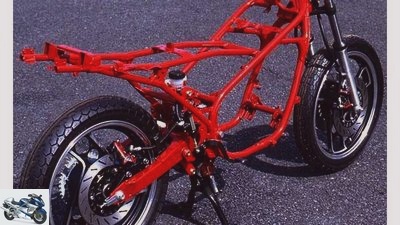
archive
Double loop frame.
With the Yamaha RD 350 YPVS from the 1980s, the designers relied on the classic frame concept of the legendary TZ series, but with comparatively thin steel tubes. Even if the steering head area was reinforced with a few gusset plates, this was the weak point of the Yamaha and sometimes caused immense problems in driving stability. To curb the vibrations of the 350 two-cylinder two-stroke engine, it was screwed to the front mounts in elastic rubber elements.
Monotube frame
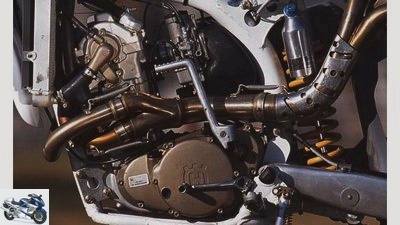
archive
Monotube frame.
With this simple frame concept, a steel tube as thick as an arm extends from the steering head to the swing arm bearing. Mostly installed in enduro and motocross machines, the stability was sufficient to tame the relatively low engine output of around 50 hp. In connection with a divided lower frame loop, the so-called joists, this construction principle has also been used in inexpensive road machines to this day
established.
Bridge frame with beams
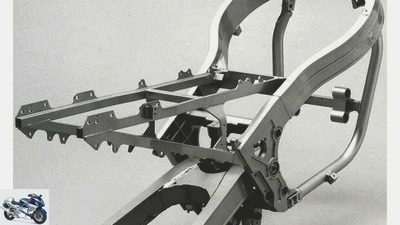
archive
Bridge frame with beams from Kawasaki ZX 10.
In the mid-1980s, the first aluminum bridge frames with a welded rear frame became socially acceptable, with stable extruded aluminum profiles welded between the steering head and the swing arm mounting. But instead of integrating the motor as a load-bearing element, it was fastened in massive, bolted pipe beams with elastic bearings. The massive cast parts in the swing arm bearing area, where the high forces of the central spring system are supported, are clearly visible.
Aluminum bridge frame
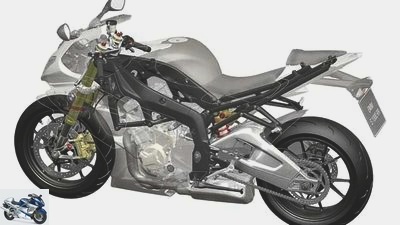
manufacturer
Aluminum bridge frame in the BMW S 1000 RR.
BMW also adheres strictly to the Japanese framework concept with the new S 1000 RR. Welded from different cast segments, the four-cylinder in-line engine drastically increases the actually enclosed space and thus the rigidity due to the rigid screw connection to the cylinder head and in the swing arm bearing area.
Truss bridge frame
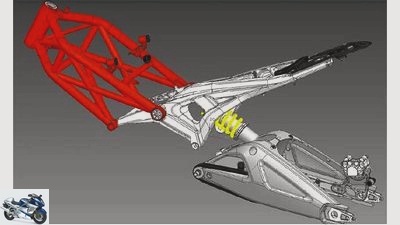
BILLION
Truss bridge frame.
Since the first V2 engines, Ducati has relied on the construction principle that makes use of the enormous rigidity of triangular assemblies. The result is light and stable tubular frames, which in the case of the Monster with the screwed tubular steel / cast aluminum composite also ensure a chic look.
Tubular steel bridge frame
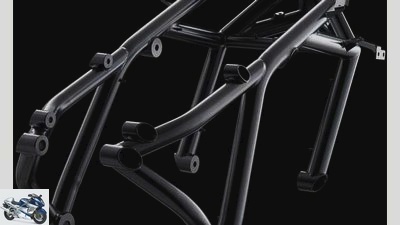
Mitterbauer / KTM
Tubular steel bridge frame from KTM.
KTM screws the large V2 engine of the RC8 at six symmetrical points to form a stable composite and dispenses with any welded cross struts in the rear frame area. Thanks to the tube walls, which are only 1.5 and 1.2 millimeters thick, the frame was 7.2 kilograms (without rear frame), almost three kilograms lighter than the Japanese aluminum constructions.
Load during emergency braking
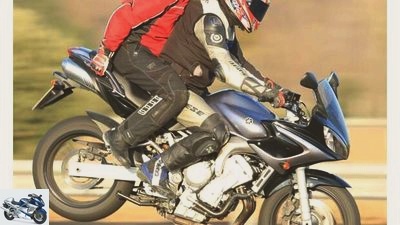
archive
Braking deceleration with 9.806 m / s2: Lever arm approx. 800 mm from the wheel radius and fork length (immersed) and 350 kg braking force at the wheel contact point.
The steering head area is exposed to extreme bending moments when braking. Due to the leverage of the front wheel radius and fork length, the lower area is compressed backwards, while the frame on the upper steering head bearing is stretched. Strong cross stiffeners prevent the frame profiles from expanding.
Load on the steering head above: approx. 950 kg
Load on the steering head below: approx. 1200 kg
Load with payload
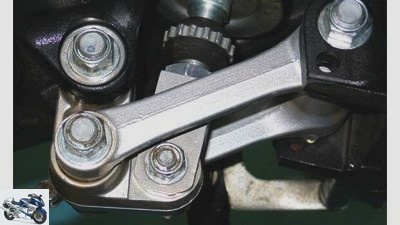
Cook
By translating the spring force on the reversing levers by a factor of two, load peaks of up to a thousand kilograms act on the frame.
At the maximum total weight (around 460 kg), around 65 percent of the load is on the rear of the frame. In the case of deep bumps, this load can double due to the dynamic compression process.
Related articles
-
Kawasaki 15th pictures archive 1/15 The frame is crucial for the driving behavior. archive 2/15 When designing the main frame, the following parameters,…
-
Technology: new motorcycle frame concept
Melly Technologies counselor technology & future Technology: new motorcycle frame concept Technology: new motorcycle frame concept Blockbusters With the…
-
Superbike World Championship: technology of the Aprilia and Ducati factory machines
motorcycles Superbike World Championship: Technology of the Aprilia and Ducati factory machines Superbike World Championship: Technology of the Aprilia…
-
Janus Halycon 450: vintage look with ancient technology
Janus Motorcycles 7th pictures Janus Motorcycles 1/7 Leaked in advance: The new Janus Halycon 450. With the license engine from China, it should cost the…
-
Kawasaki adapts Bimota technology: patent for stub axle steering
Kawasaki 6th pictures Kawasaki 1/6 Kawasaki has patented a steering knuckle system. Kawasaki 2/6 The Kawasaki system relies on a single-sided swing arm…
-
The technology of the chassis and suspension
Bilski counselor technology & future The technology of the chassis and suspension Technology: rear wheel The technology of the chassis and suspension…
-
Cook 10 pictures Cook 1/10 If you doubt your driving ability because every curve radius becomes a hexagon and the motorcycle no longer meets a line, a…
-
Guide: Technology – engine lubrication
BILLION counselor workshop Guide: Technology – engine lubrication Guide: Technology – Motors and Drive Everything about engine lubrication To ensure…
-
motorcycles Enduro Technology Honda CRF 450 R Technology Honda CRF 450 R For the sake of simplicity Why complicated when it can be made easy? This is…
-
Technology: suspension-chassis
fact accesories landing gear & Spring elements Technology: suspension / chassis Technology: suspension / chassis Suspension and chassis explained simply…